Start the new year with a bang. The kind of bang that puts you in the thick of the action.
Dolby Atmos. What was once hailed as the future of cinematic sound is fast becoming mainstream. It’s been ushered into major cinemas and heading straight for your home theatre.
Here’s everything you need to know about Dolby Atmos and how you can set up your own Dolby Atmos home theatre. Your ears are in for an absolute treat…
What is Dolby Atmos?

To understand Dolby Atmos, let’s begin with its predecessor – Dolby Digital surround sound.
By now, you’re probably rocking or at least familiar with a surround sound setup like 5.1 (5 speakers plus subwoofer) or 7.1 (7 speakers plus subwoofer).
This surround sound tech allows filmmakers to direct sounds to specific channels and therefore specific speakers. Typically, dialogue will come out of centre channels, music out of left and right, sound effects out of the surround sound speakers and low frequencies out of the subwoofer.
In a Dolby Atmos setup, filmmakers can now finally have complete freedom as sound is no longer tied to channels. Instead, each sound is recognised as an individual entity called an audio object, which can be precisely pinpointed anywhere in the 3D space around you, including from above.
So what this mean for you?
It means you’ll be experiencing a much more immersive soundscape that flows smoothly around you from all angles. You’ll be able to track the sound like never before. If it’s raining in the movie, you’ll hear it directly above you. If a chopper flies over you, the sound will start from behind, move overhead and disappear ahead of you.

Dolby Atmos at the Cinemas
Dolby Atmos supports up to 128 simultaneous audio objects and the best way to showcase this scope is through an elaborate setup of 64 speakers – not exactly easy to pull off at home but readily available at your nearest cinema.
In Melbourne, you can experience Dolby Atmos sound technology for selected screenings at major cinema chains like Hoyts, Village Cinemas and Reading Cinemas.
Dolby Atmos at Home
Once you hear a demo at the cinemas, there’s no going back – you’ll want your own Dolby Atmos home theatre.
Thanks to object-based audio, the number of speakers can be scaled down dramatically. While nothing can rival a 64 speaker setup in the cinema, you can still enjoy the same multidimensional sound experience at home.
Dolby Atmos Setup
First, you’ll need an AV receiver that supports Dolby Atmos. Most AV brands have added Atmos support to their range such as the Yamaha AV series.
For your Dolby Atmos speaker setup, you’ve got several options:
- Dolby Atmos ceiling speakers
- Dolby Atmos enabled soundbar
- New Dolby Atmos enabled speakers
- Add-on modules to existing speakers
Whichever option you end up choosing, the principal remains the same – a Dolby Atmos sound system basically adds height dimension to your surround sound for a more immersive sound.
Dolby Atmos Ceiling Speakers
For the best possible Atmos experience at home, you’ll want in-ceiling speakers. This will deliver the most realistic overhead sounds.
If the thought of drilling holes in your ceiling makes you wince, then it’s time to call one of our expert technicians. They’ll drill and install your ceiling speakers faster than you can say ‘get to the chopper!’.
Dolby Atmos Enabled Soundbar
If you’re looking for a simple plug and play solution, or if you don’t have much space, you can buy a Dolby Atmos enabled soundbar that can offer a more immersive experience than regular soundbars.
New Dolby Atmos Enabled Speakers
If you’re starting from scratch, you can buy integrated units that contain speakers with built-in upward firing drivers to recreate the overhead effect.
Add-on modules to Existing Speakers
The good news is, if you already have surround sound speakers, there’s no need to replace them. There are modules available that you simply attach to your speakers so that sound can be directed upwards to bounce off the ceiling, in effect, to recreate overhead sound.
Dolby Atmos Layouts
A Dolby Atmos sound system supports either 2 or 4 height speakers in a surround sound layout of 5, 7 or 9 speakers.
The most common home configurations for Dolby Atmos are:
- 5.1.2
- 5.1.4
- 7.1.2
- 7.1.4
5.1.2 Setup
In this setup, there is a total of 5 traditional surround sound speakers plus 1 subwoofer and includes either 2 Dolby Atmos enabled speakers or 2 add-on modules.
For ceiling speakers, it’s a total of 5 traditional surround sound speakers plus 1 subwoofer and 2 additional ceiling speakers.
Dolby Atmos enabled speakers/add-on modules
Please Note: The angles in the diagrams below represent the optimal speaker placement range relative to your listening position.
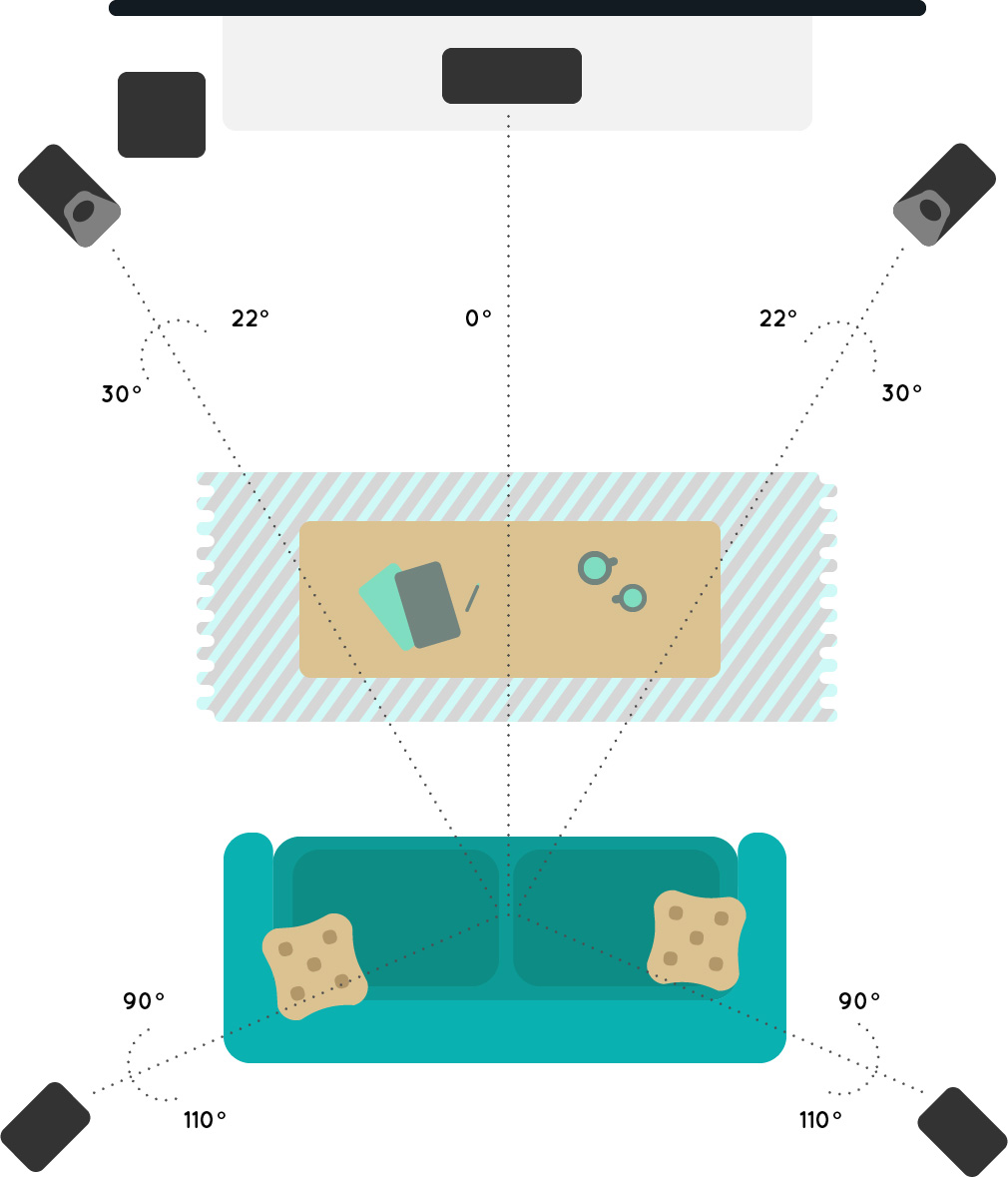
For Dolby Atmos enabled speakers, place them at the left and right front locations.
For add-on modules, place them on top of the left and right front speakers.
Ceiling speakers
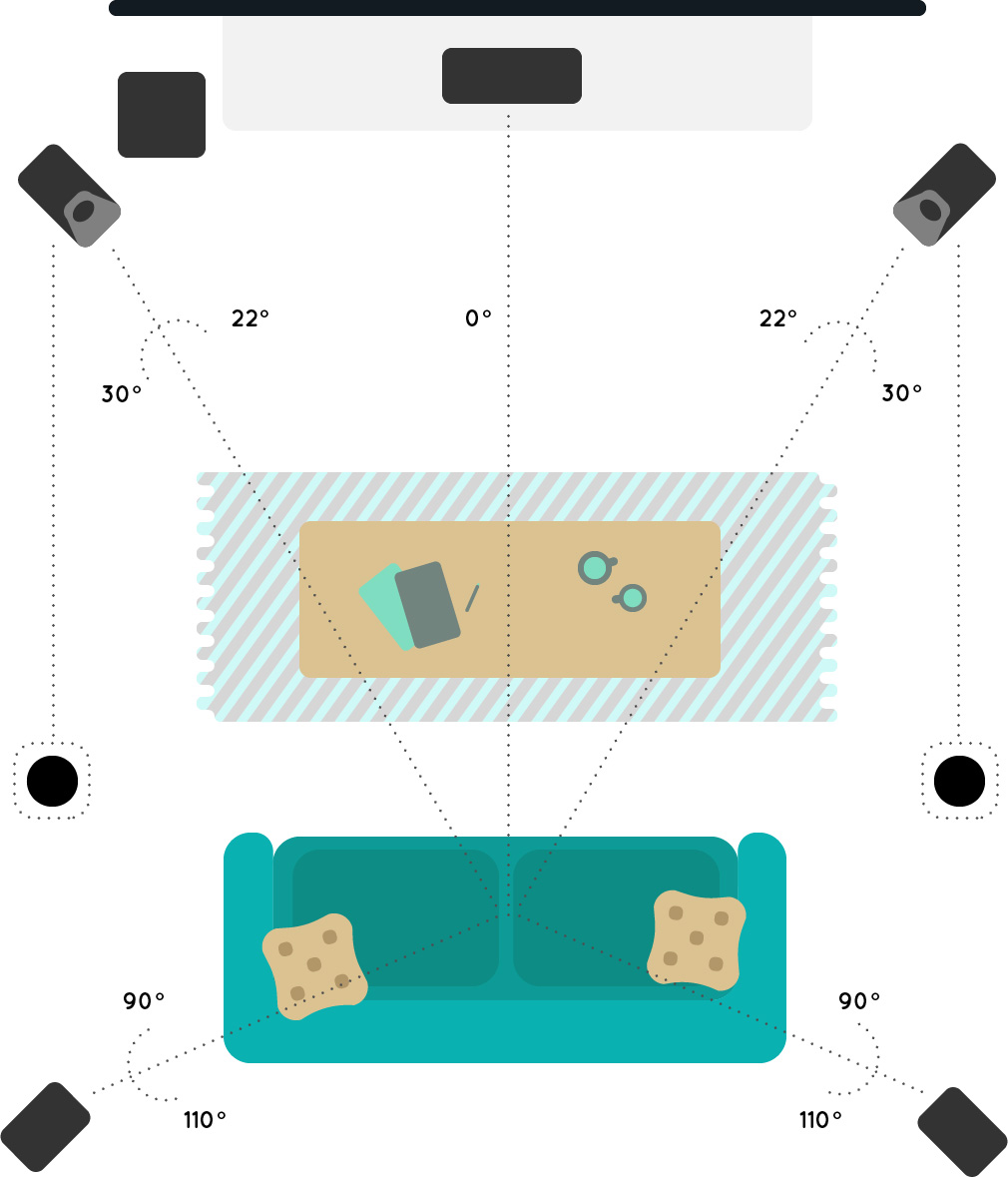
The ideal ceiling height is between 7.5 and 12 feet.
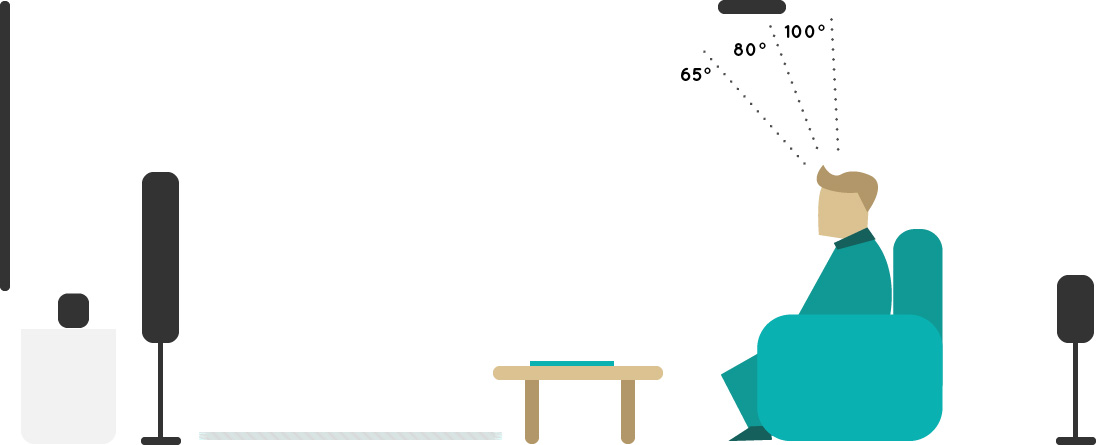
5.1.4 Setup
In this setup, there is a total of 5 traditional surround sound speakers plus 1 subwoofer and includes either 4 Dolby Atmos enabled speakers or 4 add-on modules.
For ceiling speakers, it’s a total of 5 traditional surround sound speakers plus 1 subwoofer and 4 additional ceiling speakers.
Dolby Atmos enabled speakers/add-on modules
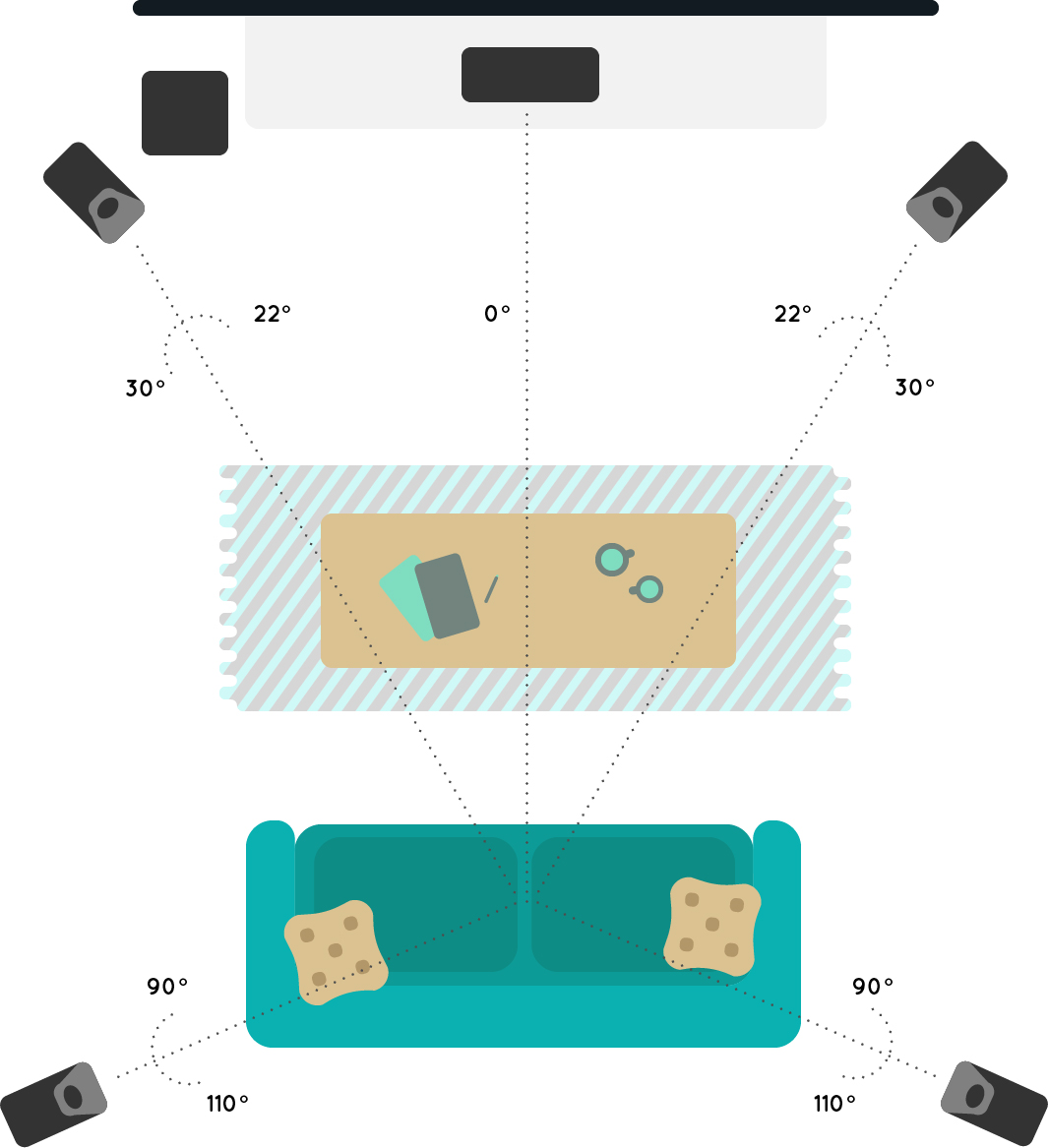
For Dolby Atmos enabled speakers, place them at the left and right front locations and at the left and right surround locations.
For add-on modules, place them on top of the left and right front speakers as well as the left and right surround speakers.
Ceiling speakers
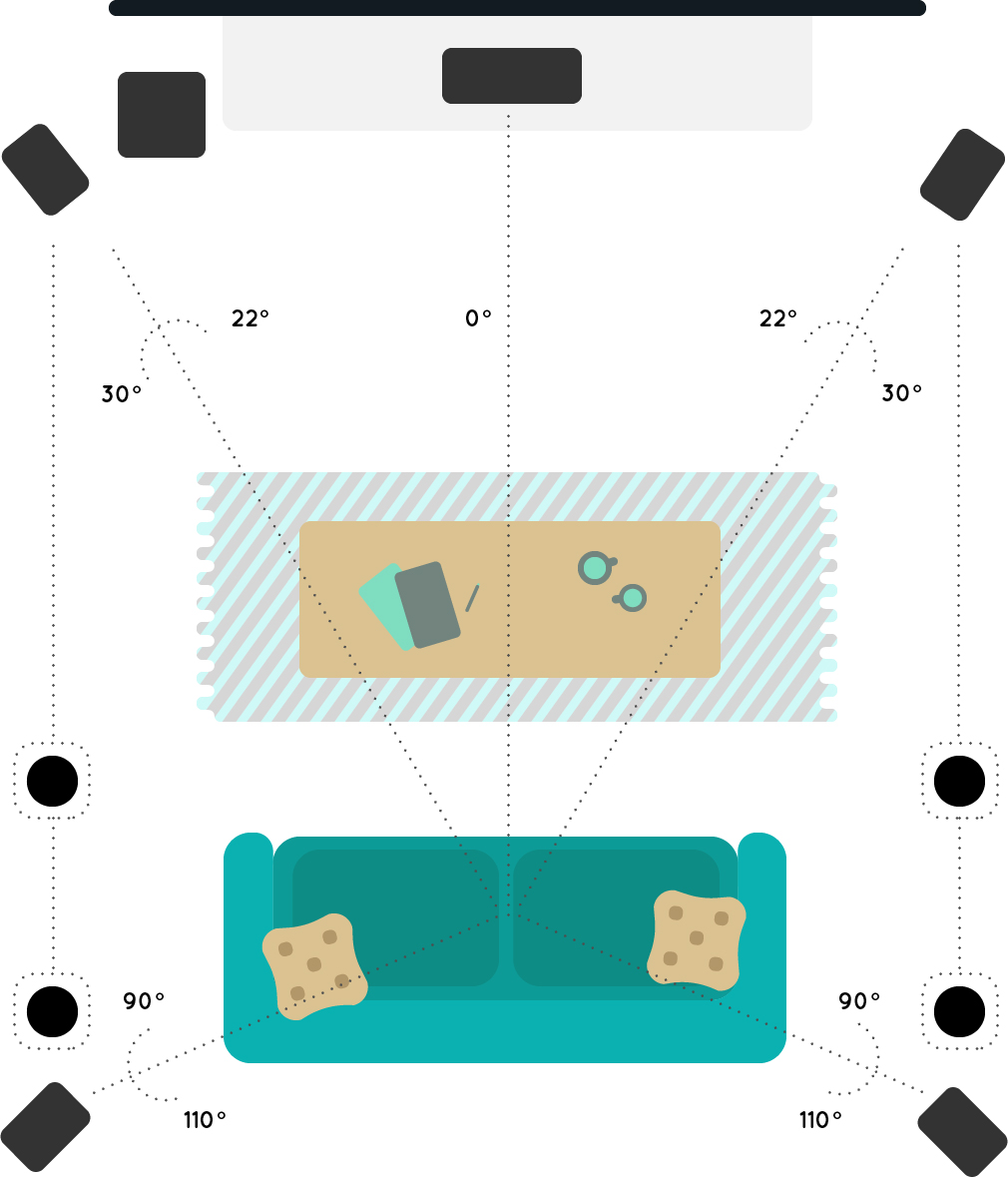
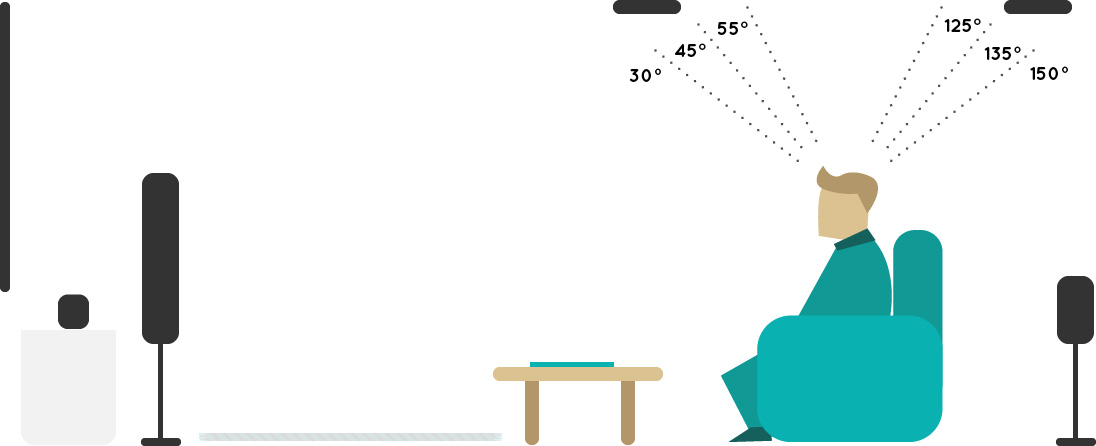
7.1.2 Setup
In this setup, there is a total of 7 traditional surround sound speakers plus 1 subwoofer and includes either 2 Dolby Atmos enabled speakers or 2 add-on modules.
For ceiling speakers, it’s a total of 7 traditional surround sound speakers plus 1 subwoofer and 2 additional ceiling speakers.
Dolby Atmos enabled speakers/add-on modules
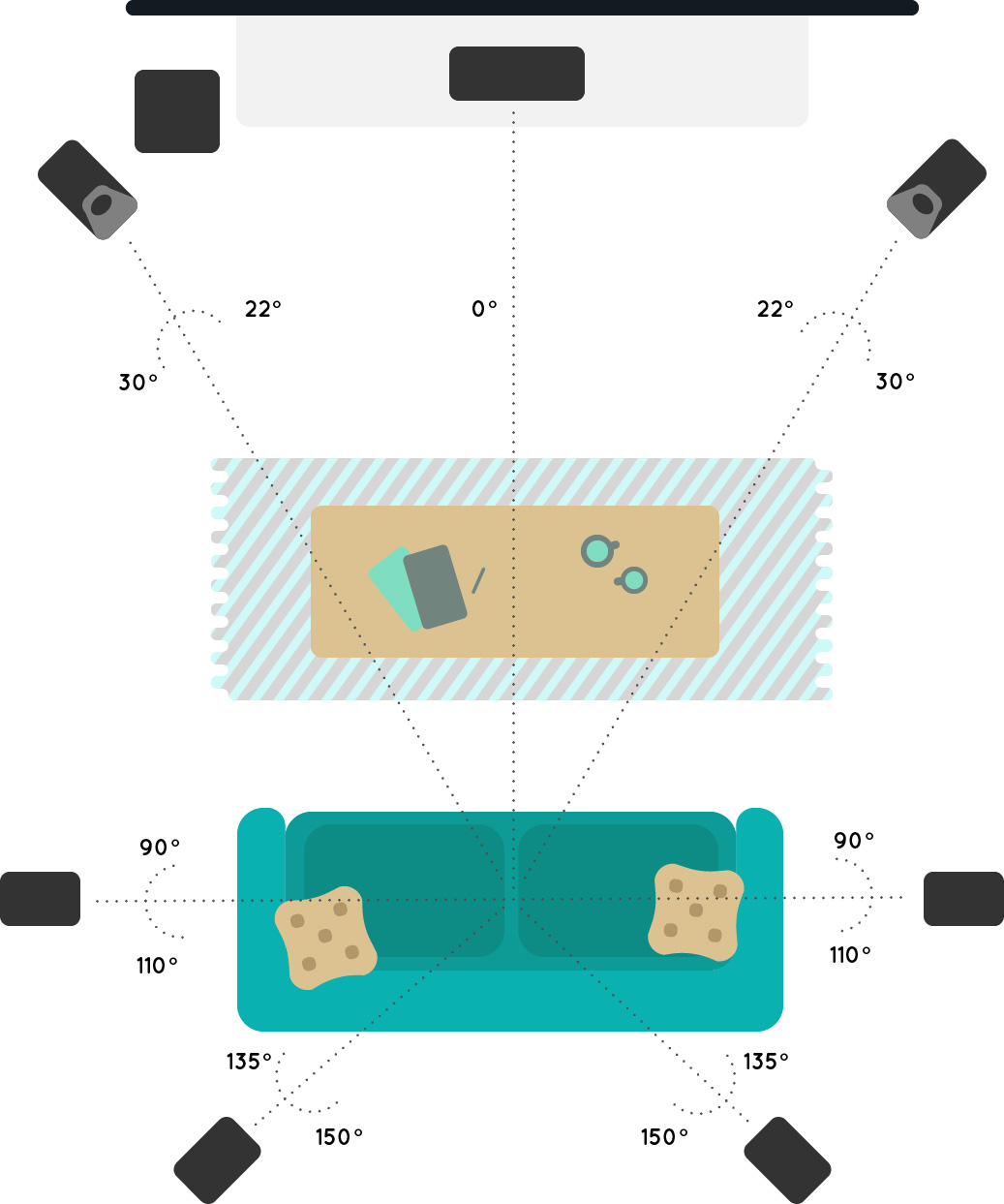
For Dolby Atmos enabled speakers, place them at the left and right front locations.
For add-on modules, place them on top of the left and right front speakers.
Ceiling speakers
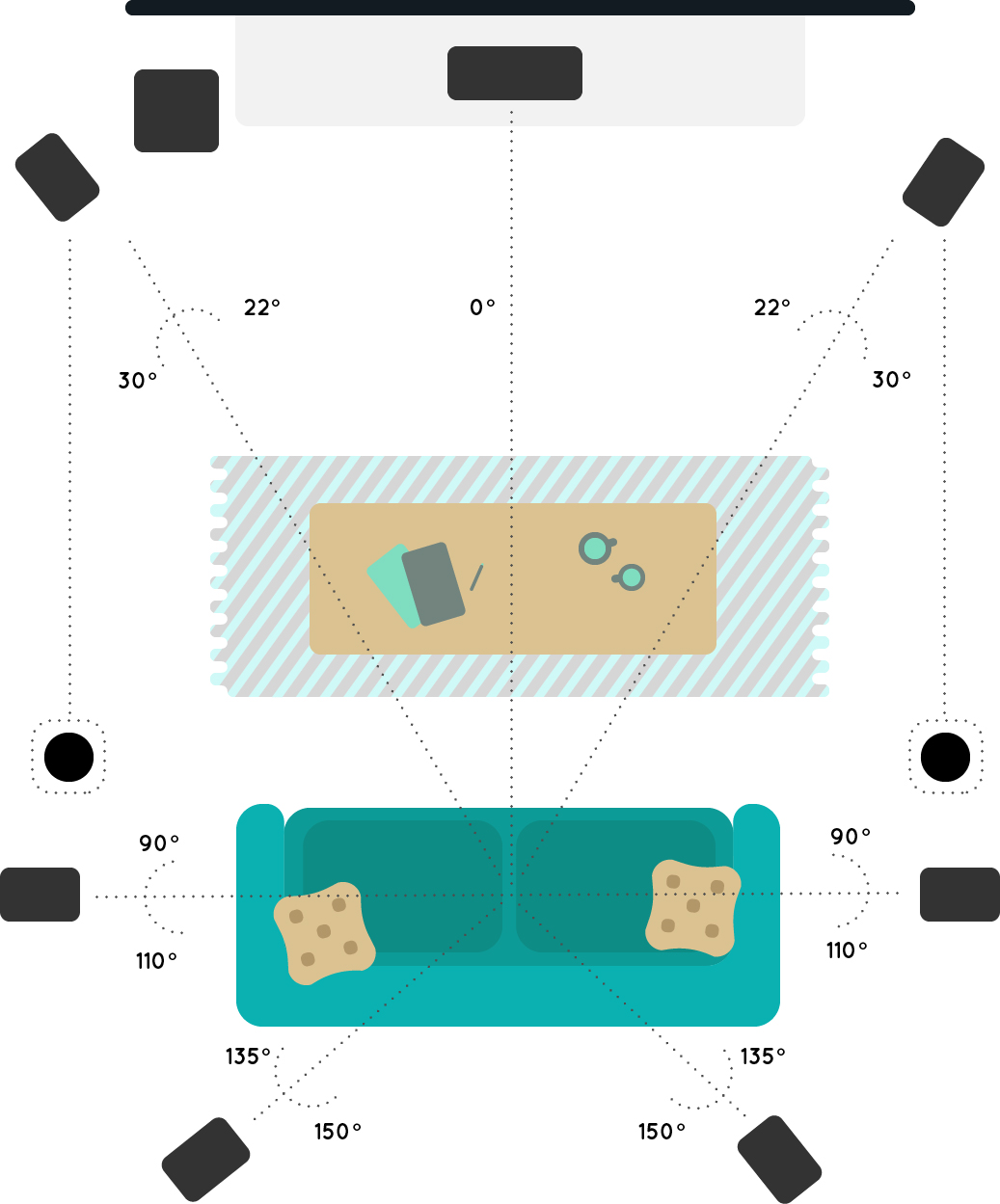
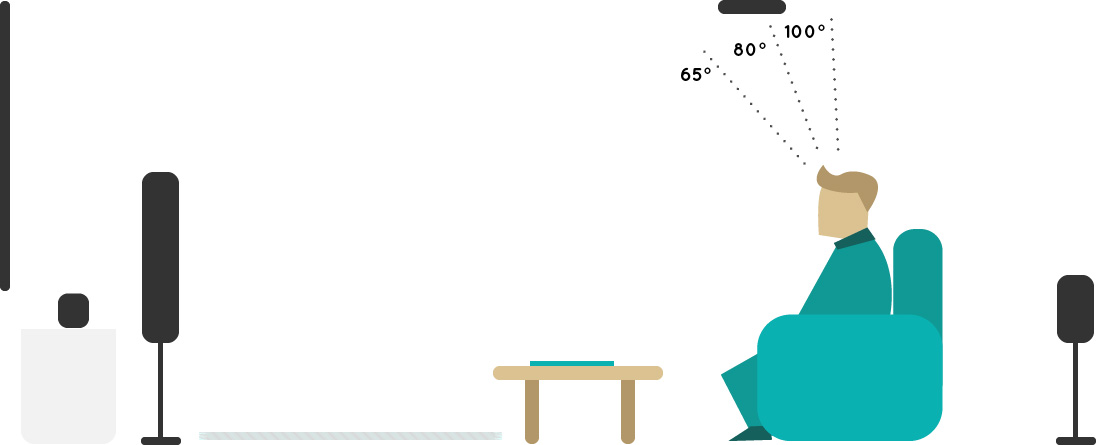
7.1.4 Setup
In this setup, there is a total of 7 traditional surround sound speakers plus 1 subwoofer and includes either 4 Dolby Atmos enabled speakers or 4 add-on modules.
For ceiling speakers, it’s a total of 7 traditional surround sound speakers plus 1 subwoofer and 4 additional ceiling speakers.
Dolby Atmos enabled speakers/add-on modules
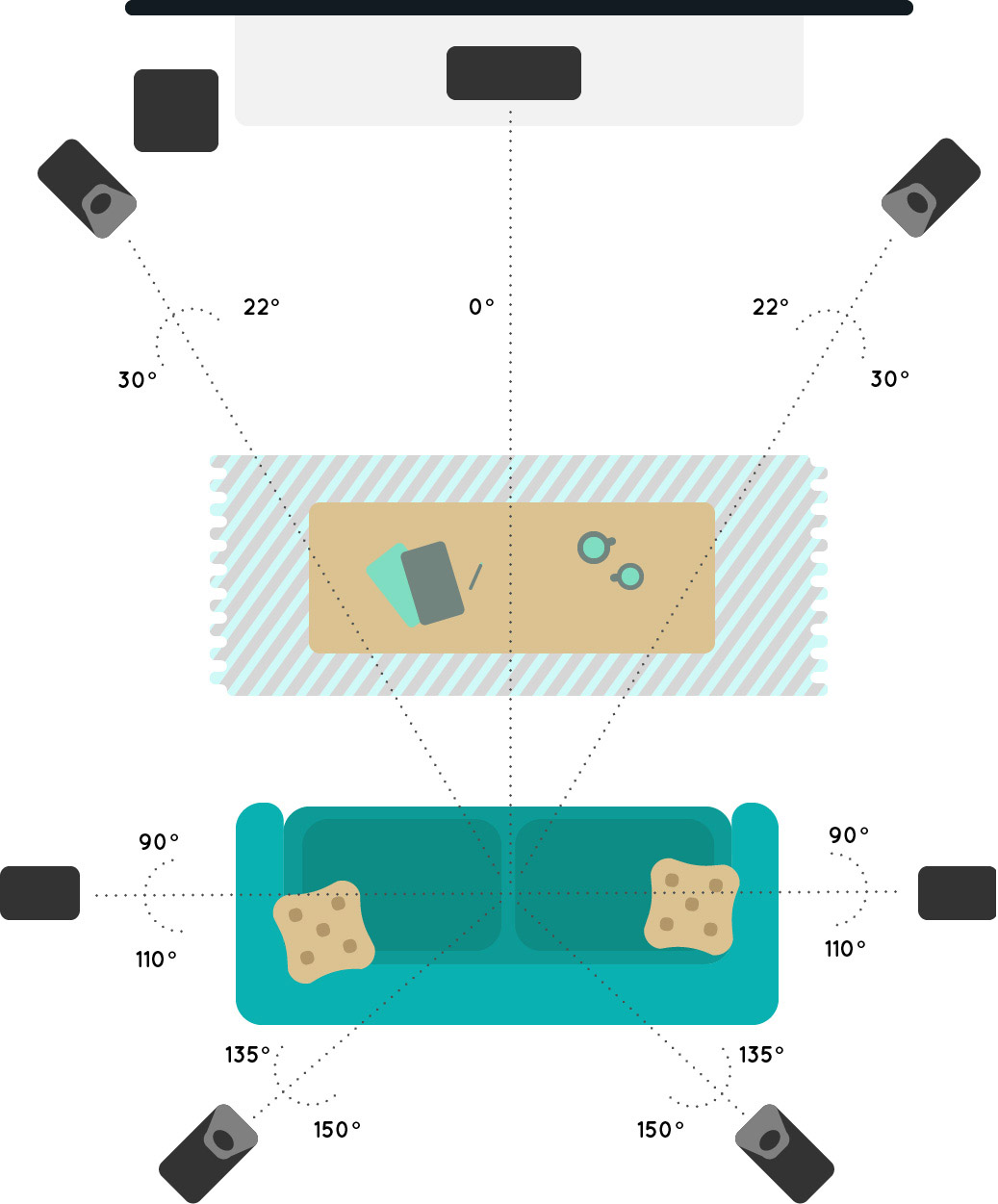
For Dolby Atmos enabled speakers, place them at the left and right front locations and at the left and right surround locations.
For add-on modules, place them on top of the left and right front speakers as well as the left and right surround speakers.
Ceiling speakers
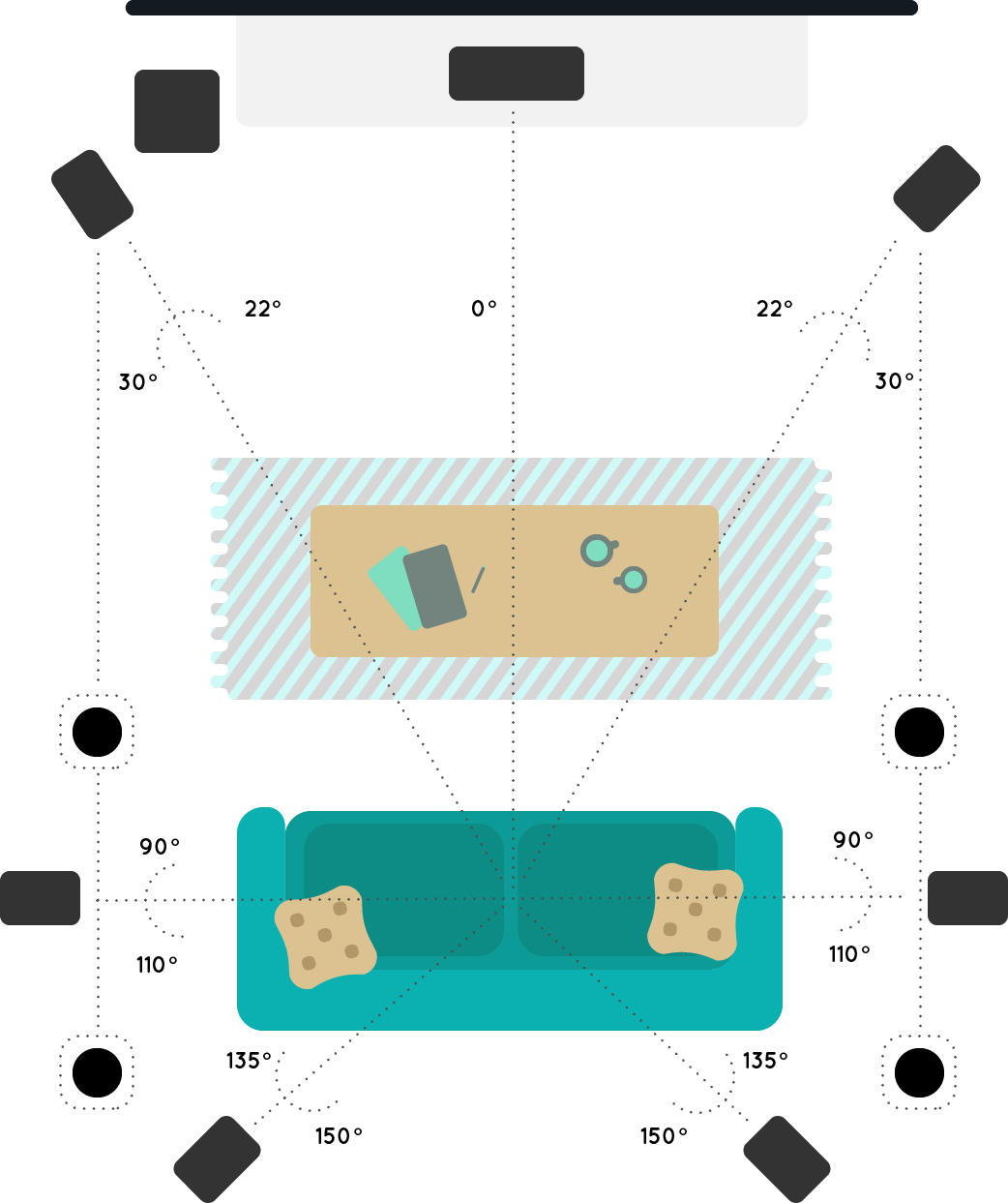
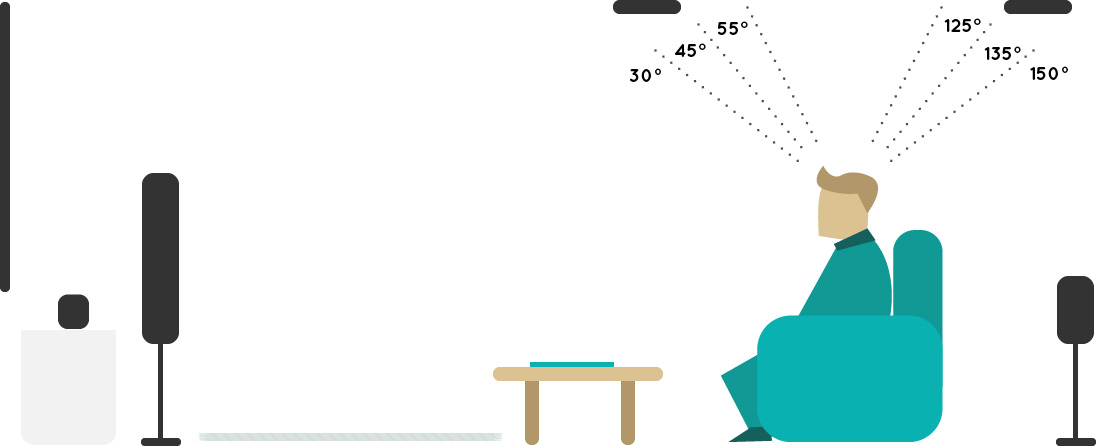
Dolby Atmos Content
Most new Blu-ray players will be capable of playing Dolby Atmos-enabled Blu-ray discs.
For streaming services, you can now enjoy Dolby Atmos Netflix with selected titles supporting the new sound format. From October of this year, Apple TV 4K will also roll out the biggest range of Dolby Atmos movies anywhere.
Be sure to check out our shop soon for our range of Dolby Atmos speakers and soundbars.
